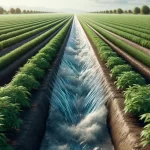The quality of water is a function of the specific use to which it will be destined, whether it is water for human consumption, for agricultural or industrial use, for recreation, or to maintain environmental quality. The FAO defines it as an important characteristic that affects the health of ecosystems and human well-being, such as the health of a community, the food to be produced, economic activities and biological diversity. Water quality is determined by comparing the physical and chemical characteristics of a water sample to water quality guidelines or standards.

Fecal Coliforms:
Fecal coliforms are a simple parameter to control the health conditions with which food is prepared. It is a standard procedure of choice in the case of live molluscs (clams) and their culture waters.
Floating Matter:
Floating matter is considered to be the solids of a sample that are retained in a mesh with a 3 mm square opening.
Fats and oils:
In the measurement of fats and oils, a specific substance is not measured, but a group of substances with the same physicochemical characteristics (solubility). So the measurement of fats and oils includes fatty acids, soaps, fats, waxes, hydrocarbons, oils and any other substance capable of being extracted with hexane.
Electric conductivity:
Conductivity is defined as the ability of water to conduct an electrical current through dissolved ions.
Total, dissolved solids:
It is a measure of the matter in a water sample, which is smaller and cannot be removed by a traditional filter. TDS is basically the sum of all the minerals, metals, and dissolved salts in the water and is a good indicator of the quality of the water.
Sodium:
Sodium in irrigation water affects soil permeability and causes infiltration problems. The excess of sodium displaces the Calcium and Magnesium and causes the dispersion and disintegration of the soil. The soil becomes hard and compact in dry conditions and reduces the infiltration of water and air through the pores that make up the soil.
Boron:
Boron (B) is an essential element and potentially toxic to plants when it exceeds the optimum level only slightly. It is found in almost all natural water and is one of the most toxic constituents of irrigation water.
Carbonates and bicarbonates:
The water contains carbonates and bicarbonates that are measured as alkalinity of the water, which affects the pH of the growing medium. Carbonates and bicarbonates are linked to calcium, magnesium, sodium and other dissolved ions in irrigation water.
Acidity or alkalinity:
The alkalinity of water is also known as the buffering capacity of water. In general, the alkalinity of water is due to the content of carbonates and bicarbonates in solution, which are very common in groundwater. When crops are irrigated with water of these characteristics, they have the same effects, so it is important to know what the alkalinity of the water means and to know how to decide when a treatment is necessary.
Absorption ratio:
The Sodium Absorption Ratio (SAR) is a calculation based on the concentrations of sodium, magnesium and calcium that estimates the tendency of water to promote compaction and caking of the soil. The higher the RAS, the less suitable the water is for irrigation.
Heavy metals:
Heavy metals are a group of chemical elements that have a high density. They are generally toxic to humans and among the most likely to appear in the water we highlight mercury, nickel, copper, lead and chromium. High concentrations of heavy metals in groundwater used for irrigation have the potential to cause physiological damage to agricultural crops, decrease quality and yield of crops. In addition, there are effects on human health from the consumption of contaminated products.
Example of heavy metals in irrigation water:
Arsenic, Cadmium, Cyanide, Copper, Chromium, Mercury, Nickel, Lead and Zinc.
| Parameter | Symbol | Normal values allowed. | Unity |
|---|---|---|---|
| Fecal Coliforms | CF. | 1,000 – 2,000 | NMP of Fecal Coliforms/100mL |
| Floating matter | MF. | ABSENT | Matter retained in mesh between 2.8 mm and 3.3 mm opening. |
| Fats and oils | GyA | 0 – 15 | Mg/L o ppm. |
| Electric conductivity | C.E. | 0 – 3 | dS/m |
| Total, Dissolved Solids | TSD | 0 – 2,000 | Mg/L |
| Sodium | Na+ | 0 – 40 | mEq/L |
| Chlorine | Cl- | 0 – 30 | mEq/L |
| Boro | B | 0 – 2 | Mg/L o ppm |
| Carbonates | CO3 2- | 0 – 0.1 | mEq/L |
| Bicarbonatos | HCO3- | 0 – 10 | mEq/L |
| Acidity or alkalinity | pH | 5.5 – 7.5 | pH |
| Sodium Adsorption Ratio | RAS | 0 – 15 | mEq/L |
| Heavy Metals: | |||
| Arsenic | As | 0 – 0.2 | Mg/L o ppm. |
| Cadmium | Cd | 0 – 0.05 | Mg/L o ppm. |
| Cyanide | CN- | 0 – 2.0 | Mg/L o ppm. |
| Copper | Cu | 0 – 4.0 | Mg/L o ppm. |
| Chrome | Cr | 0 – 0.05 | Mg/L o ppm. |
| Mercury | Hg | 0 – 0.005 | Mg/L o ppm. |
| Nickel | Ni | 0 – 2 | Mg/L o ppm. |
| Lead | Pb | 0 – 5 | Mg/L o ppm. |
| Zinc | Zn | 0 – 10 | Mg/L o ppm. |
 AgronoBlog – Agriculture Blog
AgronoBlog – Agriculture Blog 


